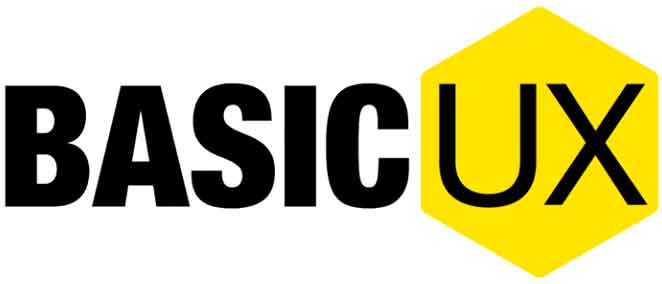
The problem is this…
While information and opinions on ‘good UX’ are increasing in availability, teams, organizations, and individuals still struggling to define, measure, and agree upon principles of UX in a productive manner. That is, a lot of UX discussions end in design arguments. Meanwhile, the developers are waiting for direction, the designers are waiting for correction, and the end-users are waiting for a satisfying experience.
Enter BASIC UX
BASIC UX does not set out to be the ‘end all, be all’ of UX principles. It does set out to help solve or at least reduce the problem stated above — UX design in productive environments is harder than it should be.
Here’s how BASIC UX works…
First, each letter in the word BASIC stands for a UX principle.
- Beauty
- Accessibility
- Simplicity
- Intuitiveness
- Consistency
Each principle then has a set of qualifying questions. If you can answer ‘yes’ to the questions, then you have satisfied that principle’s requirements in the framework.
That’s it.
I’ve been using BASIC UX to evaluate products in a number of Medium blog posts. I have to say, it’s very Beautiful, Accessible, Simple, Intuitive, and Consistent. That being said, it is definitely heuristic — it’s more qualitative than quantitative. But it is better than the alternatives.
What are the alternatives?
Alternative #1: Give everyone in the company a popular UX book and hope this new enlightenment translates into better UX in the product line.
Outcome: Inevitably, the person with the most persuasion and pull gets their interpretation of UX pushed into the product. This might be an executive, a developer, a designer, or a project manager. It could even be a customer. Books are great and necessary, but at some point we need frameworks to break down knowledge into digestible and applicable models.
Alternative #2: Make one person or small group in the company the UX ‘Nazis’.
Outcome: This takes its toll on the culture of the company. This ‘Nazi’ group or person ends up being despised, and rogue features will float past them. Don’t be surprised if there’s division between the developers and the designers.
Alternative #3: Use nothing at all, and let the loudest person in the room get their way.
Outcome: This is the most pervasive route companies take, usually because they feel that UX is simple and anyone can decide what looks good. What ends up happening here is the same as #1 above. The most assertive person gets their UX views into the product.
There are other options out there, but I could not find any that solve the problem in a concise way. So I created BASIC UX.
Please give me your feedback
I want this to be on open source framework build on solving real problems. The only way that can happen is for the feedback to continue. I like the agreement I’ve gotten so far, but I also welcome any criticism.
BASIC UX
A set of common principles that test something’s overall user experience.
Beautiful
Is it aesthetically pleasant?
The look and feel of a product is important to its overall user experience. The Aesthetic-Usability Effect shows that a visually appealing design is perceived as easier to use than an ugly one. Developers should refer to style guides and design specs for reference here. A few pixels can make a design look ‘off’ and leave the product feeling ‘broken.’
Questions to ask
- Is it aesthetically pleasant?
- Does it follows the style guide? (Attractive things work better)
- Are high quality images and graphics used? (balance with size optimization)
- Is it properly aligned with the layout?
Accessible
Can ‘everyone’ use it?
A product’s accessibility is measured by how available and usable it is for people, regardless of their ability. Developers must go beyond the ‘average’ user and ensure that those with disabilities are also able to use the product. These disabilities might include: poor or no vision, color blindness, lack of motor skills, lower than average intelligence, etc. In these cases, third-party software such as mouse-dictation and screen readers are often used to navigate and perform actions within the product. Using existing standards such as WCAG, 508 compliant, and W3C will help increase the overall accessibility of the product. Subtle accessibility impacts should also be kept in mind when choosing font size, colors, and animations.
Questions to ask
- Does it comply to standards? (WCAG, 508 compliant, W3C)
- Is it cross-browser compatible? (IE8–11, CH, FF, SF)
- Is it ‘display’ responsive?
- Is the language simple enough for most to understand?
Simple
Does it make life easier?
Hick’s Law states that the time it takes to make a decision is proportionally related to the number and complexity of choices. Additionally, Ockham’s Razor states that simplicity should be the deciding factor when choosing between two identical designs. Developers must then create user interfaces that distill the options to only what is needed to perform the user’s task.
Visually, this means balancing the use of white space and alignments to create associations, rather than complex graphics and styling. The Principles of Gestalt informs us that the use of distance, alignments and color similarities can help guide a product in a clean, simple and intuitive manner. For language content, this means reducing redundancy, removing passivity and filler words.
Questions to ask
- Does it reduce the user’s workload? (automate where possible,reduce user’s workload)
- Is it free of clutter and repetitive text? (Cognitive load, DRY text, KISS)
- Is its functionality necessary? (YAGNI)
Intuitive
Is it easy to use?
The Gulfs of Evaluation and Execution (Norman 1986) help us understand the usability gaps that users face in any system. Evaluation happens when the user is trying to understand the state of the system. If the state is not clear, the user might unnecessarily repeat an action, or feel a sense of anxiety that their task wasn’t completed. Execution is needed for a user to achieve their goals. If the path of execution is unclear, then the user won’t know how to achieve their goals in the system. If either one of these “gulfs” are too wide, then users will not have a good experience in the system and will dread using it.
Affordance is another key aspect of an intuitive UX. For example, the color of links or the shape of buttons indicates that there is an action available. It’s import to realize that most people spend most of their time with other products and in other systems. Thus, building upon established design patterns is key.
Questions to ask
- Is the functionality clear (Affordance and Gulfs of Evaluation/Execution)
- Can the user achieve their goal with little or no initial instructions?
- Is the task easily repeated by the user without further instruction?
- Can the user predict the outcome/output?
Consistent
Does it match the system?
Consistency is the thread that holds BASIC UX together. A beautiful product is consistent. An accessible product is consistent. A simple product is consistent. An intuitive product is consistent. In UX, consistency is the thing that separates frustrating chaos from cohesive harmony. It is important that design colors, spacing, fonts and alignments are uniform throughout the product. This visual and functional uniformity creates a sense of dependability and trust between the user and the system.
Developers should reuse existing and established elements in the system whenever possible. Forms should have consistent alerts, labels, validation, and action behaviors. If consistency is lacking, then the entire UX will be as well. Performance glitches should be minimized so that pages load as a consistent rate and actions produce predictable responses.
Questions to ask
- Does it reuse existing Interfaces/Interaction?
- Is its language, images, and branding consistent with the system?
- Does it appear in the right place at the right time? (workflow, navigation,visual hierarchy and information architecture)
- Does it perform consistently every time?
Conclusion
User Experience Design is at the forefront of product management in today’s industries. However, in spite of this vast and growing knowledge-share on the topic, UX Design is still a difficult area to gain team consensus around. It is in these situations that frameworks can provide clear direction. BASIC UX is a user experience design framework made up of five key design principles. It strives to help developers and designers guide their products in the right direction while remaining productive in the development process. I encourage you to introduce BASIC UX to your team and use it to enhance the experiences your products deliver.




